Through the Clear Dome”: A Storyteller’s Guide to Glass Air Fryers & Non-Toxic Cooking
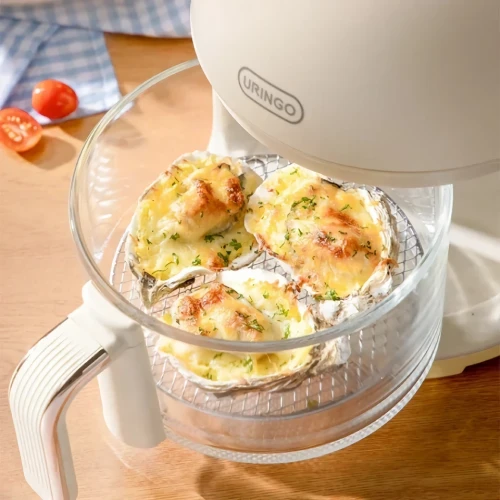
If you’ve ever peered through the little window on a conventional air fryer and wished you could watch the magic from all angles—golden edges crisping, bubbles of steam rolling, herbs fluttering like confetti—then the glass air fryer is your kind of stage. This is a story about that stage: about clear bowls and halogen halos, about families who want crispy without worry, and about what “non-toxic” really means when we’re chasing weeknight dinners and weekend feasts.
I’ll tell it to you like a campfire tale, but pack it with the practical bits you’d expect from a diligent reviewer. By the end, you’ll know how to pick a safer, cleaner-cooking glass air fryer, how to keep it shining, and what kinds of meals make it sing.
The Kitchen with the Squeaky Floor
Mara lived in a kitchen with a famously squeaky floor. If you tiptoed for tea at midnight, the floor tattled on you; if you danced while stirring risotto, the boards sang along. The kitchen was small, humble, loved.
Mara’s daughter, Pip, was eight and curious about everything—especially the way food changed when it met heat. “Why does bread become toast?” Pip would ask, nose pressed to the oven glass. “Why does salmon become pinker and then somehow less pink?” She wanted to see transformation, not just taste it after the fact.
Mara did, too—though she had another fascination: safety. Her tabs were packed with articles about cookware coatings and materials. “If we’re going to make crispy potatoes every Sunday,” she often mused, “let’s do it without mystery layers that flake or fumes that fly.”
That’s how the glass air fryer arrived in the squeaky kitchen: a bowl as clear as a raindrop, a heating element that glowed like a small sun, and the promise that the only things between food and heat were air and glass.
What Counts as “Non-Toxic,” Really?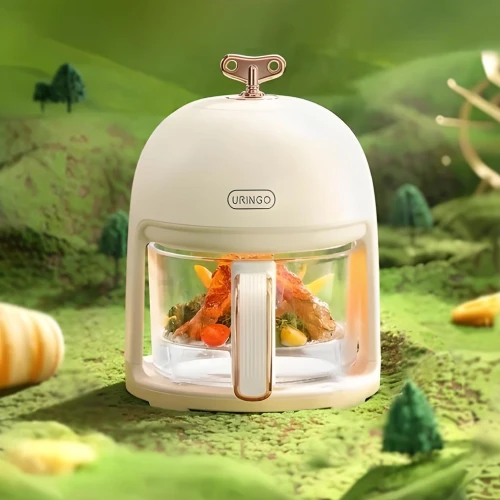
Before we follow Mara and Pip’s experiments, let’s name the dragon in this story: ambiguity. “Non-toxic” gets thrown around like seasoning, but the flavor varies. For air fryers and countertop ovens, here’s the practical translation:
Food-contact surfaces matter most. The part touching your food should be inert—think borosilicate glass, stainless steel, or unglazed ceramic. These materials don’t leach chemicals under normal cooking temperatures.
Avoid questionable coatings on baskets or trays. Many traditional air fryers use nonstick coatings. Some are PTFE-based (commonly associated with Teflon); others are ceramic-like sol-gel coatings. If “PFAS-free” matters to you, check for explicit statements like “PTFE- and PFOA-free” and “PFAS-free,” and verify that the surfaces touching food are glass or steel.
Plastic proximity. Some lids and housings use high-heat plastics; that’s not automatically bad if they’re BPA-free and out of the airflow path. Still, if your goal is maximum simplicity, prefer units where hot air meets glass and steel, not plastic.
Sealants and gaskets. Even glass units have silicone gaskets or seals. Food-grade silicone is generally accepted as safe; if you’re sensitive, confirm the silicone is platinum-cured or labeled food-grade and not in direct contact with food.
In short: if you can see the cook chamber is mostly glass, if the rack is stainless steel, and the brand openly states PFAS-free food-contact surfaces, you’re on the clearer side of the non-toxic spectrum.
The Three Glass Air Fryer Archetypes
In Mara’s quest (and in my testing), three “characters” emerged in the glass air fryer world:
- The Glass-Bowl Halogen Convection Oven
A large, clear borosilicate glass bowl with a lift-off lid housing a halogen heating element and a fan. It’s like a tiny spaceship that roasts a chicken in plain view. Pros: superb visibility, simple construction, typically no nonstick coating required. Cons: the lid is heavy, halogen bulbs run hot and bright, some models can be loud.
- The Hybrid Glass-Basket Air Fryer (Top-Load)
Looks like a modern air fryer, but the basket walls are glass. A top or side lid holds the heating element. Pros: classic air fryer feel with better visibility and fewer coatings. Cons: often smaller capacity than the big-bowl style; replacement parts may be brand-specific.
- The Glass Door Countertop Oven with Air Fry Mode
Think mini-oven with a full glass door and stainless racks. Pros: multi-function (toast, bake, air fry), easy tray swaps, often excellent temperature control. Cons: not every “glass door” model is free of nonstick trays; you must check included accessories.
“Non-Toxic” Review Criteria (The Rules of Our Tale)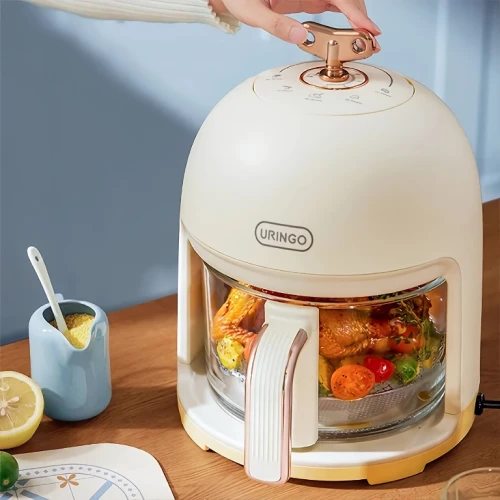
When I put glass air fryers through their paces (and yes, Pip was there for the potato portion of the testing), here are the criteria I used—and what you should use, too:
Materials & Build
- Is the main cook chamber glass (ideally borosilicate for thermal shock resistance)?
Are racks/trays stainless steel (304/18-8 is common)?
-
- Are food-contact components PFAS-free and PTFE/PFOA-free?
Does the unit reach and hold the set temp within ±10–15°F?
Are controls simple, with a visible temperature readout and timer?
- Airflow & Crisping
- Even browning without flipping every two minutes?
- Minimal “hot spots” or “cold shadows”?
- Ease of Cleaning
- Can the glass bowl or basket go in the sink without drama?
- Are there no hidden nooks that trap oil near electronics?
- Do parts survive routine degunking with mild detergent and soft pads?
- Noise & Light
- Some units hum, some roar; some halogen lids shine like the sun. Is that okay for your kitchen vibe?
- Footprint & Capacity
- Will it fit your counter—and your appetite?
- The bowl style often holds a whole chicken; hybrid baskets tend to be 2–4 quarts.
- Spare Parts & Longevity
- Can you get a replacement lid, rack, or bulb (for halogen)?
- Does the brand provide clear documentation and support?
The Trials of the Squeaky-Floor Lab
Mara’s tests weren’t lab-certified, but they were as honest as a hungry family’s dinner clock. Here’s what went down.
Trial 1: The Potato Gauntlet
Why potatoes? Because they reveal airflow truth. You want crisp exteriors, creamy centers, minimal sticking, and even color.
- Glass Bowl Halogen:
Preheat 4 minutes at 400°F. Tossed Yukon Gold wedges with a whisper of avocado oil and salt. Laid on a stainless rack over the glass bowl. Within 8 minutes, the room smelled like a bistro. At 16 minutes, edges were lacquered. Even browning with a slight halo effect near the center. Flip once for perfection. - Hybrid Glass Basket:
Similar preheat. The transparent basket helped Pip spot early browning and call a strategic shake. Crisp level: A-. Slight hotspot near the rear, but manageable by rotating the basket halfway through. - Glass Door Oven:
Trays gave the most surface area. With convection fan on, results were even but needed a few extra minutes for equivalent crunch. Bonus: easy to do a second tray for guests.
Non-Toxic Notes:
No nonstick chips, no flakes, no mystery—cleanup was soap and a soft sponge. The stainless racks took on a “seasoned” patina that wiped clean with a baking-soda paste.
Trial 2: The Salmon Silk Test
Why salmon? Because protein sticks, and stinking up a machine is a fast way to hate it.
- Glass Bowl Halogen:
Brushed rack with a tiny bit of oil. Skin-on fillets at 375°F. In 9–11 minutes, we got crackly skin and tender centers. Odors cleared quickly thanks to the open glass design—no lingering plastic smell. - Hybrid Glass Basket:
Needed parchment cut to size or a light oil film on the rack to avoid occasional sticking. Once dialed in: excellent. - Glass Door Oven:
Wins for delicacy control—precise temp holds and easy tray insertion. Also easiest to slide out without breaking the fillets.
Non-Toxic Notes:
Again, food met glass and stainless. No coatings to baby. The glass walls made residue visible, so you actually clean what you can see—a hidden perk of transparency.
Trial 3: Sweet Things (Apples & Hand Pies)
- Glass Bowl Halogen:
Apple chips went from leathery to crisp with a lower temp and the lid cracked for steam release. Mini hand pies browned beautifully, though halogen’s top heat can over-brown edges—drop temp 10–15°F or lower the rack. - Hybrid Glass Basket:
Even, predictable, and adorable to watch puff up. Pip’s verdict: “It’s like a bakery in a snow globe.” - Glass Door Oven:
Best for batch baking. If you’re into dehydrating fruit or making granola, the multi-tray oven style is the patient, consistent friend.
The Clear Advantages (Why Glass Wins for Many)
- Visibility That Changes Your Cooking
Transparency changes behavior. You rotate, shake, and adjust because you can see what’s happening. That reduces burning, undercooking, and guesswork. - Simpler Food-Contact Surfaces
With glass bowls and stainless racks, there’s often no nonstick layer to scratch or off-gas at typical cooking temps. For the non-toxic-minded, that’s peace of mind. - Flavor Purity
Glass doesn’t hang on to smells the way some plastics can. Clean it, and it’s neutral again. - Easy to Assess Cleanliness
If grease clings to the wall, you’ll see it. That encourages better maintenance and better performance.
The Trade-Offs (Because Honesty Is Part of Safety)
- Weight & Handling
Glass bowls are heavy. Lids on halogen models can be awkward; learn the lift-and-lock dance to avoid steam on fingers. - Heat & Light
Halogen is bright and intense. Sensitive eyes may prefer hybrid or glass-door oven models with shaded housings or different elements. - Footprint
The big-bowl units gobble counter space. Measure twice, buy once. - Replacement Parts
Halogen bulbs and control lids vary by brand. Before you commit, check parts availability.
How to Choose Your Glass Air Fryer (A Simple Path)
- Decide Your “Why.”
- Non-toxic first? Prioritize borosilicate glass + stainless with documented PFAS-free claims.
- Family batches? A glass-door oven with trays might fit best.
- Show cooking & whole chickens? Glass-bowl halogen is a spectacle and a workhorse.
- Check the Materials List.
Look for borosilicate (often labeled), 304/18-8 stainless, food-grade silicone, and explicit PTFE/PFOA/PFAS-free where relevant. - Controls & Consistency.
A reliable thermostat matters more than a dozen presets. Knobs or digital—either is fine if temps are accurate. - Cleaning Reality.
Can the bowl fit your sink? Are racks dishwasher-safe? Are nooks sealed away from crumbs? - Support & Spare Parts.
If the brand lists racks, lids, gaskets, or bulbs as separately purchasable, that’s a green flag for longevity.
Care & Keeping: Make It Last (and Stay Non-Toxic)
- Skip abrasive pads on glass; use soft sponges and a baking-soda paste for stubborn bits.
- Degrease racks with hot water + dish soap; for burnt sugar, soak then gently scrape with a nylon tool.
- Avoid thermal shock. Don’t douse hot glass with cold water. Let it cool for a few minutes first.
- Ventilate. Even with inert materials, airflow prevents lingering cooking odors and keeps electronics happier.
- Use parchment when it helps. Parchment or a stainless mesh liner reduces sticking for delicate foods.
- Season the rack (lightly). A whisper of high-heat oil on a dry, warm rack can reduce sticking—just wipe off excess.
What to Cook First (So You Fall in Love)
- Herb-Salt Potato Wedges
Quarter Yukon Golds, toss with oil, salt, chopped rosemary. 400°F until blistered and gold (about 16–20 minutes). Shake once; watch the show. - Crispy Chickpeas
Drained, towel-dried chickpeas + paprika + garlic powder + salt. 380°F, shake twice, 12–15 minutes. Crunch that keeps well. - Cedar-ish Salmon (Minus the Plank)
Brush rack with oil, 375°F for 9–12 minutes. Season with lemon zest, pepper, and dill. Transparent bowl means you’ll catch the exact moment the albumin beads appear—pull then for perfect medium. - Apple Chips with Cinnamon
Thin slices, 300°F, vent the lid (or crack the door on an oven model) to let steam escape. Flip once. The kitchen will smell like a harvest festival.
The Night the Chicken Glowed
On a Friday, Mara tried the bold thing: a whole chicken in the glass-bowl halogen. She patted it dry, tucked thyme beneath the skin, slid lemon halves into the cavity, and set the rack high so heat could whirl around it.
Pip sat on a stool, chin on hands, and watched the bird turn from pale to bronzed. As the skin tightened, rivulets of fat trickled down the glass in thin, clear lines. There were no hidden chambers for splatter to lurk, no flaking liners, no chemical mystery—just heat, air, and the steadfast patience of glass.
Halfway through, they rotated the bowl. At the end, when a thermometer sang 165°F, the chicken crackled when it rested. Dinner was herb-bright and honest.
“No tricks?” Pip asked.
“No tricks,” Mara said. “Just good materials and hot air.”
FAQs (Because Every Tale Needs a Practical Ending)
Q: Are glass air fryers completely free of plastic?
A: Not always. Lids, housings, and handles may incorporate plastics and silicone, but in good designs, food and primary airflow contact glass and stainless first. Verify BPA-free and high-heat ratings for non-food parts.
Q: Do glass bowls ever shatter?
A: Quality borosilicate glass is engineered for temperature swings, but any glass can break if mistreated. Avoid thermal shock (cold water on hot glass), inspect for chips, and follow the preheat guidance.
Q: Is halogen safe? Isn’t the bulb… unusual?
A: Halogen is simply a type of incandescent heating element. It gets hot and bright quickly, delivering rapid browning. The bulb is sealed; you don’t ingest anything from it. If you’re light-sensitive, consider hybrid glass-basket or glass-door models with different heating elements.
Q: What about ceramic-coated “nonstick” trays?
A: Some “ceramic” trays are sol-gel coatings. Many are PFAS-free, but they can wear over time. If your goal is maximum simplicity, use stainless trays or unglazed ceramic and line with parchment when needed.
Q: Will food stick more without nonstick coatings?
A: Sometimes, yes—especially proteins. The trade-off is fewer chemical concerns. Use oil lightly, preheat, and try parchment or stainless mesh. After a short learning curve, you’ll get reliable release.
Q: Do glass air fryers cook faster?
A: They cook evenly and let you see progress. Halogen models can be very fast; glass-door ovens may take a few more minutes but offer precision and multi-tray efficiency.
The Clear Choice
If “non-toxic” is your north star, glass air fryers offer a refreshingly straightforward route: glass where you can see it, stainless where you touch it, and air doing the heavy lifting. They reward curiosity—yours and your family’s—because they keep the process visible and honest. You’ll flip when needed, lower heat when edges darken too quickly, and slide trays at the exact moment golden becomes perfect.
Mara and Pip still dance on their squeaky floor, and the kitchen still tattles on midnight snacks. But when they reach for crispy, they reach for the clear dome, not just to cook, but to watch cooking happen—simple, safe, and deliciously transparent.
If your next kitchen character is going to be an air fryer, consider one made of glass. Let your food meet heat with nothing to hide.
Quick Non-Toxic Checklist (Clip This on Your Fridge)
- Borosilicate glass cook chamber
- Stainless steel racks/trays (304/18-8)
- PFAS-/PTFE-/PFOA-free food-contact surfaces, stated plainly
- Food-grade silicone gaskets where needed
- Accurate thermostat and good airflow
- Parts availability (racks, lids, bulbs, gaskets)
- Fits your counter and your appetite
Cook clearly. Eat confidently. And enjoy the show.



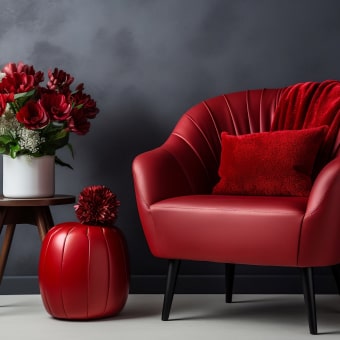
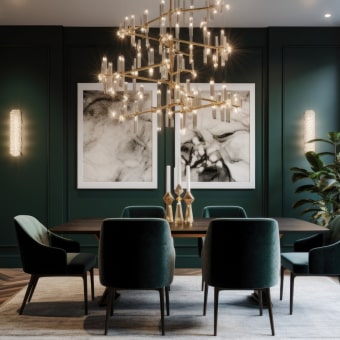

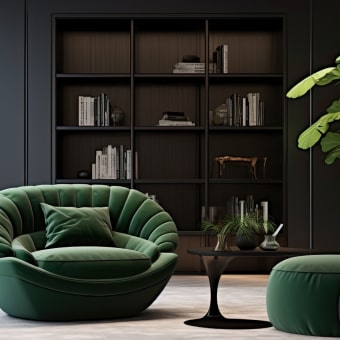











Leave a comment